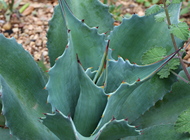 |
The adenophora project |
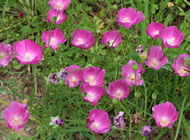 |
The adenophora conundrum
Ever since I purchased some 'Adenophora liliifolia' plants from a
well-known mail order perennial supplier many years ago, the genus
Adenophora has thrown me for a loop. I soon found out that our plants
had wickedly wandering ways (I'm still trying to eliminate it from several
areas of our garden, with limited success). What I got was probably in fact
the notorious Campanula rapunculoides.
That experience made me shy away from adenophoras for years (I did not
realize the mix-up until later), but more recently, I decided to try a few
different species. None of them are known for spreading by roots, although
some do seed to excess. By now, I have blooming specimens of three
supposedly different species: A. pereskiifolia
and A. polyantha (both from traded seed), and
A. confusa (a gift from a friend's garden). It was pretty obvious
that A. pereskiifolia was incorrectly named (the leaf shape is wrong), but was
it a different species of adenophora? Similarly, are the others correctly named?
Telling adenophora apart from campanula
Meanwhile, I had found what appears to be the standard reference on the web
about distinguishing adenophoras from campanulas, the following blurb from the
Gardens North catalog:
ADENOPHORA
About 40 species of hardy, summer-blooming plants native to Eurasia and
Japan, similar to Campanula because of their nodding, blue, bell-shaped
flowers. For full sun or part shade in average garden soils. Adenophora and
Campanula are often confused Here is a simple test for distinguishing the
two. Take a flower and gently pull off the petals, leaving the style
standing in the center. You will be left holding the base of the flower with
a bumpy appendage (the ovary) in the middle and the style sticking straight
up out of the center. VERY CAREFULLY peel off the outside of the bumpy
appendage, leaving the style standing. If underneath, all you see is a flat
base to which the style is attached, then you have a campanula. If, however,
you see, after the peeling, another bulb-like appendage surrounding the
style, then you have an adenophora. An easy way to rogue out all those
imposters!
Similarly, the brief Wikipedia
page on Adenophora states:
Many of its species are quite similar to species of Campanula,
from which they differ only through the presence of a tubular or glandular
disc at the base of the style.
So it should be easy to figure out if I have the genus right, right?
Well, I tried it out, giving the identification method a go for the
'adenophora' species mentioned above, as well as for several campanulas. The
results are shown below, with photos of the flowers in various phases of
dissection.
Adenophora confusa
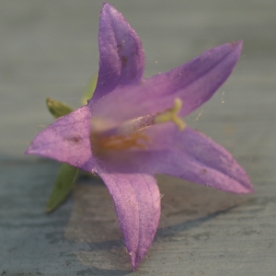
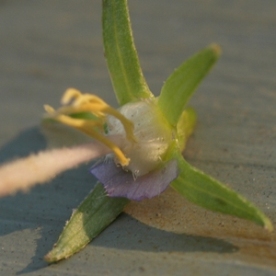
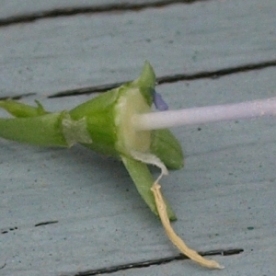
Once the fused petals are removed, you can see the white inner structure,
which again has petal-like parts. Pealing those away reveals no bulbous or
glandular disc. So it must be campanula.
Adenophora pereskiifolia
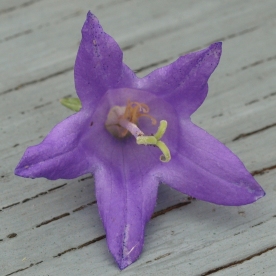
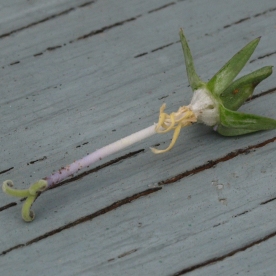
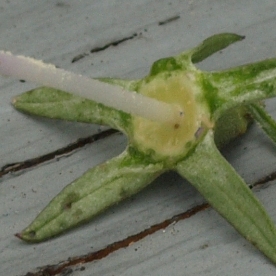
Once again, the style emerges from a flat base. That's not a glandular disc,
is it? Another campanula, it seems.
Adenophora polyantha
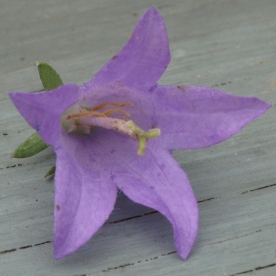
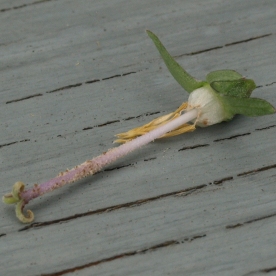

Third strike - I'm out. Same result. Now let's look at some campanulas.
Campanula cochlearifolia
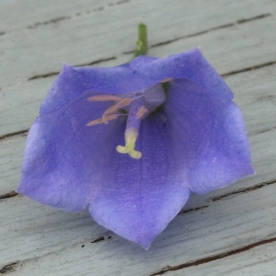
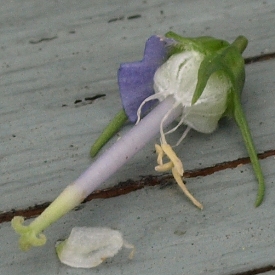
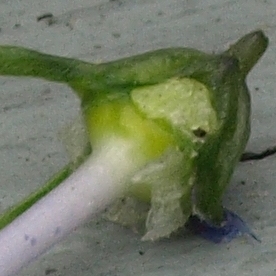
Slightly different attachment of style to base, but basically similar to
the 'adenophoras'.
Campanula alliariifolia
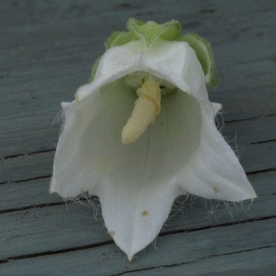
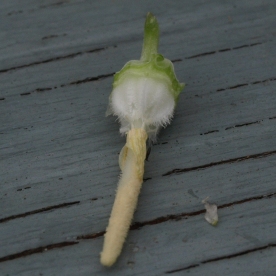
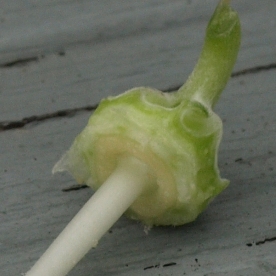
No bulbous attachment here either (although I could make an argument for
a toroidal object here).
Three weeks later...
An unknown bellflower came into bloom in my sale plot. No sign to say
what it was, and it didn't look like anything I've grown before. I took a
few pictures, and asked on GardenWeb's Name That Plant forum what it
might be — and I learned that it was most likely A. triphylla var. japonica. That made some
sense — I had tried to grow that species from seed, in what I believed
to be an unsuccessful attempt. Great! Another opportunity to put a plant to
the botanical test. Let's see how it worked out:
Adenophora triphylla var. japonica
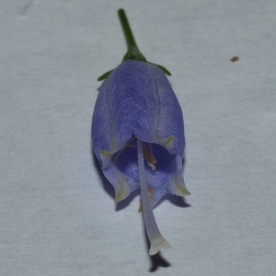
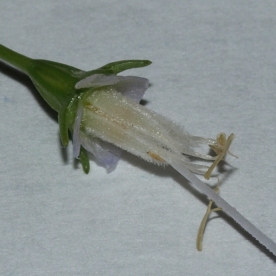
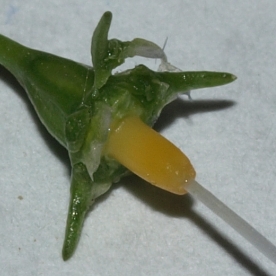
Wow! So that's what a bulb-like appendage looks like! I was delighted that
I finally had examples of both true and false adenophoras. It wasn't until a
few years later that I had another species to inspect:
Adenophora stenanthina
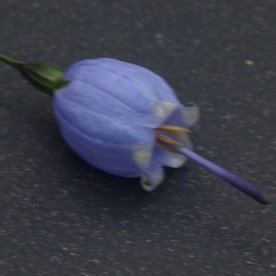
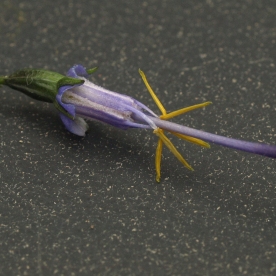
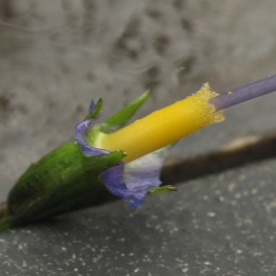
A rather different look from the first one, but still an enlarged structure.
The rest of the plant is a good match to the species, so I'm fairly confident
of its adenophoraness. I'll continue to inspect new species as the opportunity
arises.
Adenophora tashiroi?
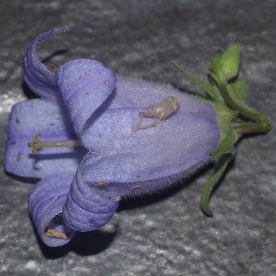
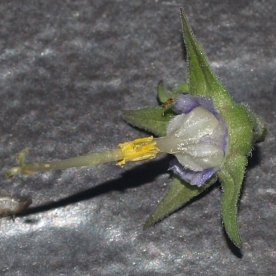
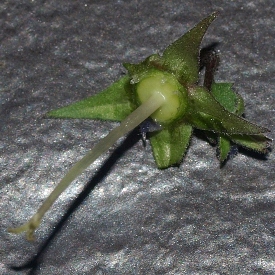
The flowers looked somewhat like those of my A. stenanthina, so I was
convinced I had an adenophora – but wait, there's no bulbous
appendage. So it's probably a campanula (still awaiting identification, but
at least something more interesting and desirable than C. rapunculoides).
The conclusion
I've proven that nearly all of the plants that came into our garden named
'Adenophora' are in fact campanulas. A fellow gardener concerned about the
grand scale at which plants sold or labeled as adenophoras in the US in fact
are campanulas struck up an email conversation with me after finding this
page. He convinced me that, although my "adenophoras" differ somewhat in
their appearances, habits, and invasive tendencies, all of them are the evil
Campanula rapunculoides. With the discovery of the stray A.
triphylla and the more recent success with A. stenanthina, I'm jubilant
that I can now count Adenophora among the genera I've grown. I'll continue
my quest for different ones, because this one looks quite different from the
campanulas I've grown, and makes a nice addition to our garden. Meanwhile,
I hope that this page will be helpful to gardeners on the web as an
illustrated guide to making the distinction.
Visitors to this page have left the following comments| Mary Beth | Jun 27, 2010 | Rob, This is very interesting and I will be out testing soon. Am I reading the first sentence of your conclusion correctly? None of the plants are campanulas? Or all are campanulas?
Ha, you caught my shifting logic as the sentence progressed. I fixed it. Looking forward to hearing about your testing! |
| Debbie | Mar 01, 2011 | I believe I have the evil one in my garden - and now in fact all of my gardens, front and back. I spent three weeks last spring trying to dig up all of the carrot like roots (over 1 foot deep) plus all of the runners and they still popped up as new plants in the fall, ready to take over my garden this spring. It seems, even if a very small piece of white root is left in the garden, it will sprout into another plant. Short of nuking the whole garden, any suggestions to eradicate?
Yeah, nearly impossible. I've not managed to eradicate it in any of the garden areas where it took hold, although in most places it's sufficiently under control that regular weeding keeps it down. But a few weeks of inattention... |
| Bee | Jul 02, 2012 | Rob: you are a TRUE master of botany and I bow before you! I have the identical mindset as you and found this thesis fascinating. Well done, Rob, well done! As a landscape architect who's B.S. is in gentics, I am also of the "Splitter" mentality vs. "Lumper"; I've already spent 6 hours tracking down that the "Scottish Bluebells" that an 80 year old woman gave me is actually Adenophora confusa, emphasis on the 'confusion'. Even the great Michael Dirr throws up his hands at some species of plants, deeming them 'too confusing to separate.' I've looked for a solid hour at images of A. confusa/spicata/lilliflora, etc. and all the photos look identical. So, I'm now using the "lumping" preinciple of A. confusa. LOL GREAT information and research; a thorough pleasure finding your page!!!!
Hi Bee – I'm glad you found my page useful. I'm not usually so inclined towards botanical distinctions, but this one really bugged me! |
| Hieke Booij | Feb 12, 2013 | By accident I came onto this page and you solved the campanula/adonphora problem for me. Thanks.
|
| Bill | Jul 02, 2013 | Last fall ( Oct 2013) , a neighbor about a mile away had 6 white garbage bags by the road labeled "Lilies " , also the colors in each bag . I have a hillside which I wish to plant with flowers to curtail erosion . I dutifully planted all the day lilies that had survived their time in a bag . This spring all came up and the first batch , orange and deep brown flowers are blooming . But a got a bonus . In one of the lily root balls was an Adenophora . It has been blooming since early june . I love it . Hope it does "seed" itself a bit . I did the flower dissection today . A Campanula ! Still its healhty , strong 2.5 ft tall , stems loaded with flower buds . Thanx for the info
As long as you have plenty of ground to cover, I guess you don't need to be too concerned about rampant spreading. I've learned to be cautious with anything that looks like a campanula, though... |
| Kathy in Lansdowne,PA | Aug 17, 2014 | I stumbled onto your great site. I'll use it as a resource now. Clear, useful,concise plant portraits, and I am IMPRESSED by your easy-to-follow path through the tangled jungle of campanula-adenophora. I know think the A.confusa-could it be better named?-acquired at the Scott Arb.exchange- is Campanula unknown, which I will treat as C.rapunculoides til I have more evidence. I'll pot it and sink it, to prevent spread, and we'll see. Many thanks! Any idea whether Eupatorium coelestium is invasive here in SE PA?
{ConocCoele:Eupatorium (or Conoclinum) coelestinum} will spread more aggressively than you might care for given the right conditions. I have patches in my vegetable garden and nursery area where it has proven to be a worthy adversary, difficult to eradicate. It's not nearly as aggressive in its original position, our partly shaded side garden. So like most things: it depends :-) |
| Kelly L. Moran | Aug 11, 2015 | Since you mention that well-known mail order nurseries are mislabeling the two plants, do you have a suggestion for a source? plants or seeds??
Thanks
Adenophora seeds ordered from Europe are more likely to be true to species than plants or seeds ordered from the US. You could try Jelitto; I'm not as familiar with other European sources. |
| Lance Wright | Jun 15, 2020 | I come to your 'article' late. Since Campanula rapunculoides has escaped and is so common now in the northern US, along with its pollen, I wonder whether it crosses with Adenophoras and if much of what is sold here now are all hybrids...any idea? |
I welcome comments about my web pages; feel free to use the form below to
leave feedback about this particular page. For the benefit of other visitors
to these pages, I will list any relevant comments you leave, and if
appropriate, I will update my page to correct mis-information.
Note that I discard any comments including
html markups, so please submit your comment as plain text. If you have a
comment about the website as a whole, please leave it in my
guestbook. If you
have a question that needs a personal response, please
e-mail me.
Last modified:
June 10, 2015
Contact me
|

























